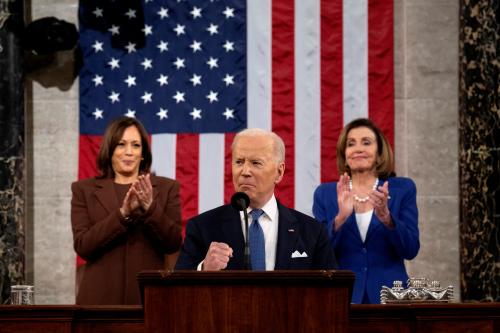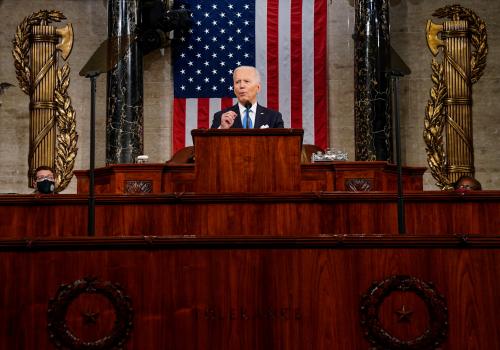By the standards of today’s polarized politics, the unity members of Congress displayed on Ukraine at President Biden’s State of the Union address was extraordinary. The hall was dotted with the blue and gold colors of the Ukrainian flag, and the introduction of Ukraine’s ambassador evoked a prolonged and passionate ovation.
But was this show of unity just a passing response to the emotions of the moment?
The answer seems to be no. To an extent rarely seen these days, the American people are united across lines of partisanship, ideology, race, and ethnicity—indeed, across every demographic marker—on the nature of the threat, who is responsible for the war, and how to respond to it.
Polling conducted right before Biden’s speech showed that the people are paying attention, with 65% saying they’ve heard a lot about the Russian invasion of Ukraine. About 8 in 10 Democrats and Republicans sympathize more with Ukraine than Russia, and three quarters say they care who wins the war. Huge majorities of both Democrats and Republicans believe that Russia wants to reestablish the border of the Soviet Union and that Ukraine wishes to remain independent.
These attitudes represent more than moral sympathy for Ukraine’s heroism in the face of Russian aggression. Large majorities of both parties believe that what happens in both Russia and Ukraine affects the United States “a lot.” 49% of Democrats and 48% of Republicans believe that Russia is “an immediate and serious threat” to the United States, and majorities of both political parties think that the chance of a new Cold War is higher than it was five years ago. 46% of Democrats and Republicans fear that war between the United States and Russia is very or somewhat likely.
There is also a strong bipartisan consensus on how the United States should respond to the Russian invasion. Supermajorities of both parties favor imposing economic sanctions on Russia and Putin and sending financial aid and weapons to Ukraine. 54% of both Democrats and Republicans favor sending troops to reinforce our NATO allies in Eastern Europe, but there is bipartisan opposition to sending US forces to fight the Russians in Ukraine.
Americans are in no mood to end the war by rewarding Russian aggression. Across party lines, they oppose promising Russia that Ukraine will never join NATO, they oppose allowing Russia more influence in former Soviet countries, and they oppose pulling back NATO troop deployments in Eastern Europe.
Many political commentators have wondered whether former President Trump’s evident sympathy for Vladimir Putin fundamentally altered the views of the Republican Party about Russia. Aside from Tucker Carlson and Steve Bannon, who celebrate Russia’s dictator because he’s “anti-woke,” the answer is no. For the first time in a long while, Americans on both sides of the aisle find themselves agreeing on something important.
These opinions are not set in stone, especially in an election year. For example, Republicans’ support for sanctions falls—more than Democrats’ support does—if sanctions lead to an increase in fuel prices. Still, the degree of agreement on the fundamentals of the invasion is remarkable and seems likely to persist.






Commentary
The invasion of Ukraine unites a divided America
March 3, 2022